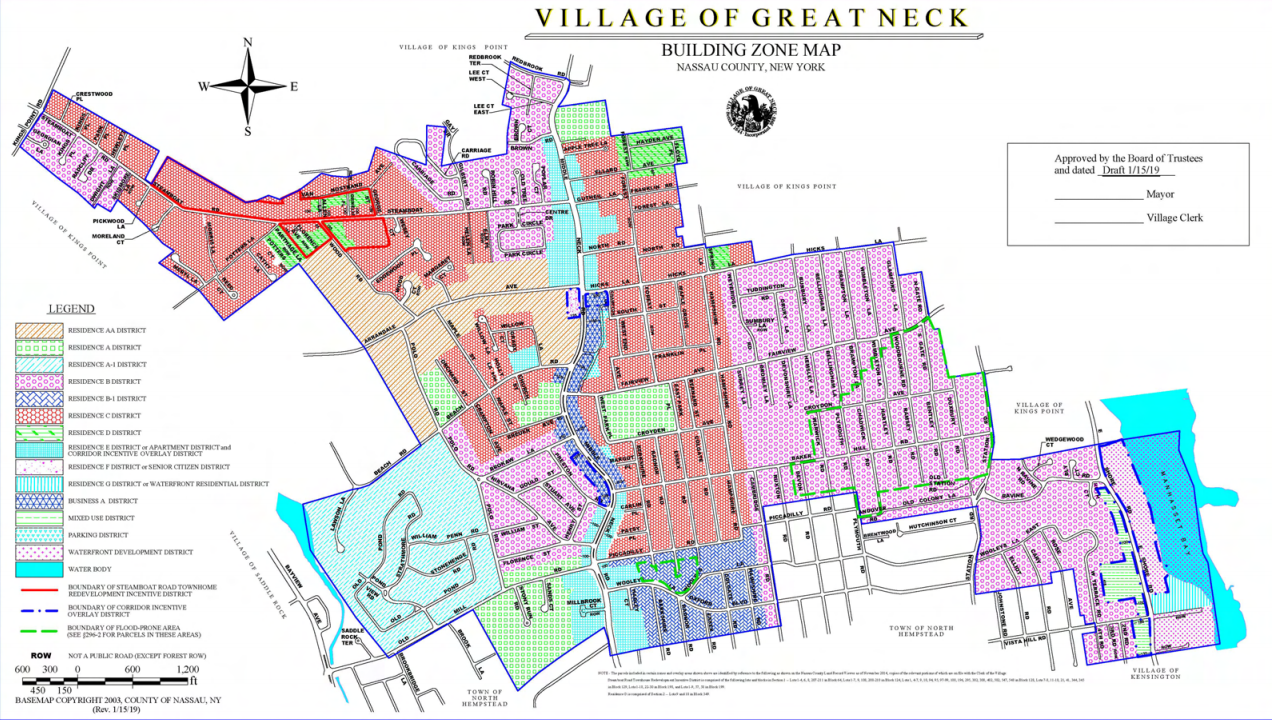The Village of Great Neck is poised to continue discussions on updating its incentive zoning, the mayor and village building department consultant said on Tuesday, while the board is likely to approve a moratorium on small residential subdivisions on Feb. 19.
Incentive overlay zoning, slated for parts of Middle Neck Road and East Shore Road, aims to encourage development by allowing for incentives to be given to developers – say, an extra floor of height – in exchange for something of benefit from said developers like affordable housing or improved waterfront access.
Great Neck village officials have been in discussions about the revitalization of the village since fall 2017, when they took on VHB, an engineering firm, as a consultant to figure out ways to help improve the area. A petition signed by about 400 people raising alarms about housing options soon followed.
The village then announced a citizens advisory committee in March 2018 to work with VHB on a study, solicit community input and serve as a liaison to the Board of Trustees. There have been a handful of presentations since then.
Now, zoning legislation is on the table and will be taken up on Feb. 19 to expand the Multifamily Incentive Overlay District, approved in 2013, to blanket over properties of interest along parts of Middle Neck Road and East Shore Road and rename it the Corridor Overlay District.
Among the changes would be allowing an extra floor of height, to be determined on a case-by-case basis by the Board of Trustees, for certain buildings that offer a defined community benefit like affordable housing or assisted living.
Robert Barbach, the former building superintendent of the village now working as a consultant for the building department, said Tuesday that the overlay district does not change the underlying zoning or guarantee a sea of four- and five-story buildings.
Rather, Barbach said, the changes are designed to incentivize developers to create projects that help the village.
“The idea is if incentives are granted, they would only be on a project-by-project basis,” Barbach said. “So nobody is entitled to walk in and build four stories, let alone this idea of five stories.”
Not many buildings would fall under this category, Barbach said. One project that might qualify, though, is adding a fifth floor to the Housing Authority of Great Neck’s apartment complex since it offers affordable housing.
In defining “affordable housing,” Barbach referred to the Long Island Workforce Housing Act, which describes it as housing for individuals and families at or below 130 percent of the median income of the Nassau-Suffolk County area.
In a separate interview, Mayor Pedram Bral said the incentive zoning aims to create the “better business corridor that everyone’s asking for” while giving the village “the right to ask them” for certain amenities that the board views as benefiting the village.
“The whole idea of incentive zoning is to bring the developers and the landlords on the negotiating table, and we can say this is what the village needs and this is what we’re willing to give them,” Bral said. “They’re not getting anything as of right.”
Barbach said technically, the Board of Trustees could vote on the legislation Feb. 19 because the Nassau County Planning Commission signed off by giving an “issuance of local determination” and they gave a month’s notice for that public hearing.
But, Barbach said, the village is still awaiting a transcript from the Feb. 5 Board of Trustees meeting – when residents flooded village hall for VHB’s presentation and raised various concerns – so they can answer “material questions” the public had on the possible impact of the legislation.
Also, given the fact that the Feb. 5 meeting fell on the Lunar New Year and many people may be away Feb. 19 during the school break, Barbach said “it is likely that the trustees will not vote on Feb. 19.”
Trustees, however, are likely to approve a six-month moratorium on small residential subdivisions within the village Feb. 19 so the village can study the issue.
“Simply put, it is a reaction to what is not uncommon throughout the peninsula: taking oversized properties, splitting them in half, and creating two houses where one used to be,” Barbach said.
Bral confirmed that the moratorium will likely be decided Feb. 19. As for the incentive zoning overlay district change, Bral said it is “very likely” they would continue the conversation in March if the need is there.
“We’re listening,” Bral said, adding that nobody “is really pushing anything through” as discussions have gone on for more than a year.
The Board of Trustees meeting will take place Tuesday, Feb. 19, starting at 7:30 p.m. at 61 Baker Hill Rd. Anyone interested can also watch a livestream of the meeting on the Village of Great Neck’s Facebook page.
A report of recommendations from VHB, an engineering firm serving as the village’s consultant on the revitalization initiative, as well as an environmental impact statement and the text of the proposed zoning amendments, can be found on the village’s website.
“People need to look at it with an open mind and see really what is it that we’re trying to achieve,” Bral said. “It’s not to put money in the pockets of developers, it’s really to revitalize our village.”



